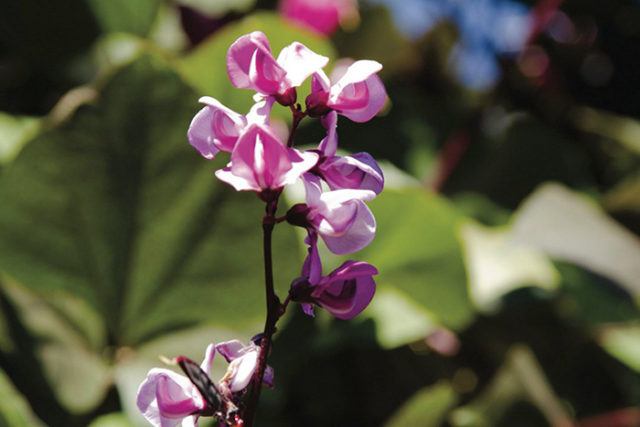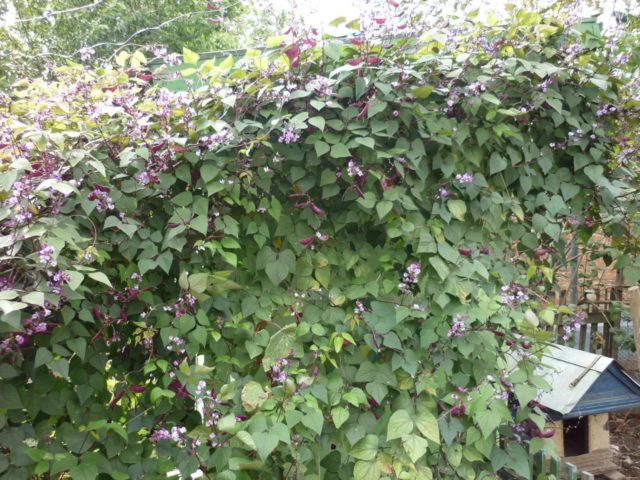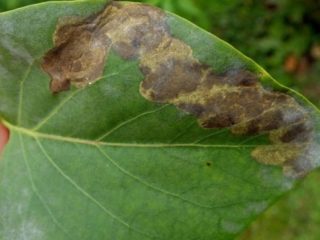Content
- 1 General description of climbing lilac dolichos
- 2 The best varieties of climbing lilacs
- 3 Growing dolichos climbing lilac from seeds
- 4 Planting climbing lilacs in open ground
- 5 Caring for climbing lilacs after planting
- 6 Diseases and pests
- 7 Application in landscape design
- 8 Use of hyacinth beans in cooking
- 9 Conclusion
- 10 Reviews
Climbing plants are an excellent way to decorate arbors, arches, and mesh structures. One of the most spectacular crops traditionally used for this purpose is dolichos, or climbing lilac. Thanks to its rapid growth and excellent decorative appearance, this plant enjoys well-deserved popularity among many lovers of landscape architecture.
General description of climbing lilac dolichos
Dolichos (hyacinth bean, climbing lilac) is an indigenous inhabitant of the tropics and subtropics of East Africa, also found in Asia. The climbing lilac belongs to the legume family.
The main characteristics of the plant are given in the table.
Parameter | Meaning |
Synonymous names | Dolichos, kokornik, hyacinth beans, Egyptian beans, climbing lilac, lobia |
Type | perennial herbaceous plant |
Escapes | A climbing, fast-growing vine of lilac-crimson color. Can reach a length of 10 m |
Leaves | Triple, pointed, heart-shaped. The leaf plate is flat, even, with clearly visible veins. Depending on the variety, the color can be green, lilac, purple, burgundy |
Flowers | Racemose inflorescences of medium-sized lilac flowers |
Fruit | Small (1-2 cm) beans of black, brown or orange color with a white comb. Ripen in green pods 10-13 cm long, which turn purple as they ripen |
Purpose | Vertical gardening, ornamental gardening |
How dolichos blooms
Flowering of dolichos usually begins in mid-July and stops only in late autumn, with the onset of frost. Inflorescences usually consist of 30-40 flowers of pinkish, white-yellow or soft lilac color. As the vine grows, new inflorescences constantly appear. Each of them lives about 3 weeks, with the lifespan of each flower being about 3 days. After pollination, flat pods of bright purple color are formed in place of the flowers.
The best varieties of climbing lilacs
Dolichos has many varieties. They differ in the color of foliage and flowers. Below are the most popular varieties of climbing lilac (dolichos) and their photos.
Sapphire
The liana of this variety of climbing lilac is distinguished by good branching and grows up to 3 m. The leaves are large, symmetrically arranged, and green. The flowers are medium-sized, blue-blue, collected in long lush clusters.
It is used as an hanging plant alone or together with climbing lilacs of another variety, creating a variety of decorative compositions.
Purple garland
The dolichos variety Violet Garland is characterized by intensive growth. During the season, the vine can grow up to 6 m. The plant is especially decorative due to its heart-shaped leaves of a reddish color, as well as bright purple inflorescences hanging like a garland.
Ruby Moon
Many consider dolichos Ruby Moon (in English transcription Ruby Moon) to be the most spectacular of all varieties of climbing lilacs. This becomes especially true in late autumn when snow falls. At this time, rich purple beans look great against a white background. The leaves of this variety are green, the inflorescences are bright purple.
The Ruby Moon climbing lilac vine can reach a length of 3 m or more. The variety is resistant to drought and heat.
Lilac cascade
The liana of this variety of dolichos can grow up to 4-5 m. It is a vigorous and rather strongly climbing plant with many side shoots. The leaves are green with a dark burgundy tint. Violet-lilac climbing flowers are collected in panicle inflorescences of about 20 pieces.
The Lilac Cascade variety is well suited for decorating the walls of houses, gazebos, and various structures. This dolichos is often used for landscaping balconies. Can withstand light frosts.
Niagara Falls
The dolichos liana of the Niagara Falls variety usually grows 3-4 m per season. The foliage is good. The flowers are lilac, bright, collected in panicle inflorescences.
The flowering of the plant continues until the onset of cold weather.
Lablab purple
Depending on climatic conditions, the vine of this dolichos variety grows 1.5-3 m. The leaves are large, heart-shaped. They are distinguished by a pointed tip and a reddish tint. The inflorescences are clusters containing up to 40 small purple flowers.
Growing dolichos climbing lilac from seeds
In the cool climate of Russia, dolichos, or climbing lilac, can only be grown from seeds as an annual plant, even in the southern regions, since any negative temperature is guaranteed to destroy dolichos. Planting in open ground is done using the seedling method after preliminary germination of the seeds at home. The seeds extracted from the pods remain viable for quite a long time, so for those who are constantly growing hyacinth beans, problems with planting material usually do not arise. Climbing lilac beans can be stored even at sub-zero temperatures, but heating above + 25 °C greatly reduces germination.
Recommended timing
To determine the optimal time for sowing dolichos seeds, subtract 50-55 days from the expected day of planting seedlings in open ground. At the time of planting climbing lilac seedlings, the likelihood of frost should be completely eliminated. In the middle zone, this is the second half of May, which means you need to sow beans for seedlings around the end of March.
Selection of containers and soil preparation
For planting climbing lilac beans for seedlings, any shallow container, for example, a used cookie or cake container, is suitable. You can also sow seeds in individual peat cups.Any soil for indoor plants or seedlings is quite suitable as a nutrient substrate; it can be bought at gardening stores.
To prepare your own soil mixture for planting climbing lilacs you will need:
- river sand;
- fine peat;
- humus;
- highland or black soil.
To disinfect, all components are calcined in the oven for 20-25 minutes at a temperature of about 200 °C. This heat treatment will thoroughly disinfect the soil and prevent fungal diseases from damaging dolichos seedlings.
How to plant climbing lilacs with seeds
Before planting, dolichos seeds need to be scarified, i.e. destroy the hard shell that covers the top of the bean. The easiest way to do this is to peel off the white ridge that is found on each bean. You can do this with any sharp tool, needle file, sandpaper. Scarified seeds are sown in moistened soil to a depth of 1 cm, then watered again. Then the container is covered with film and put in a warm, dark place.
Seedling care
It usually takes 5-7 days before the first shoots of climbing lilac seedlings appear if the seeds have been scarified. After this, the container is moved to the windowsill. If you leave it in a dark place, the plant will thin out and quickly die, so you need to constantly monitor the sown beans.Further care for dolichos seedlings consists of watering the soil as it dries and periodically loosening the soil to a shallow depth so that a crust does not form, which would interfere with the normal air exchange of the root system.
After the seedlings have deployed 4 full leaves of the plant, they can be pinched. This will give impetus to the development of side shoots. 1-1.5 months after the emergence of seedlings, they begin to harden the seedlings, periodically taking them out into the open air, first for a short time, and then gradually increasing the intervals.
Planting climbing lilacs in open ground
Before planting dolichos in open ground, you need to prepare the place. Since climbing lilacs are planted for vertical gardening, it is worth taking care in advance about the supports along which the vine will go. If these are massive structures such as a metal arch, then you need to put them in order (clean, paint) before planting the seedlings.
When to replant
Dolichos seedlings are transplanted into open ground only after the soil has warmed up sufficiently and the threat of return frosts has completely passed. In the middle zone, the right time for this is the second half of May or even early June.
Site selection and soil preparation
Climbing lilac grows well in open sunny areas; in shade and partial shade the plant feels much worse. Plants are usually planted in 1 or 2 rows, depending on the desired density. For a continuous carpet, the distance between neighboring plants is 20-25 cm, for individual vines - 50-60 cm. Double-row planting of dolichos seedlings is done in a checkerboard pattern.
Dolichos prefers loose, fertile soils with neutral acidity. A month before planting, the planned landing site is dug up, while humus is added there.
How to plant dolichos in open ground
Dolichos should be planted in open ground as carefully as possible, trying not to damage the root system. Therefore, it is preferable to grow seedlings in individual peat cups. If the seedlings are in a container, then you need to remove the plants very carefully, trying to keep the earthen ball on the roots intact. Dolichos are planted in prepared holes. In this case, the root collar is not buried, leaving it flush with the soil surface. After planting, the plant is watered abundantly, and the root zone is mulched with peat chips or sawdust. This retains moisture well in the soil and prevents weeds from developing.
Caring for climbing lilacs after planting
After planting climbing lilacs, watering should be daily until the plant takes root in its new location. Dolichos loves well-moistened soil, so in hot weather it is watered every day, and in extreme heat - twice, in the morning and in the evening. In cooler seasons, watering can be reduced to 2-3 times a week. Dolichos, like all legumes, loves breathable soils, so the root zone must be cleared of weeds, loosened and mulched.
There is no need to feed dolichos in the year of planting. For mature bushes, several types of fertilizer are usually applied per season. In early spring, the plant is stimulated to grow and gain green mass with nitrogen-containing fertilizers; during flowering, the bushes are fed with potassium compounds, and in the fall, superphosphate is added.
To maintain a decorative appearance and increase bushiness, the climbing lilac vine is periodically pinched, stimulating the growth of side shoots.
Diseases and pests
Dolichos rarely gets sick. Changes in the appearance of plant leaves are usually associated with irregularities in care, for example, a lack of potassium in the soil causes yellowing of platinum leaves. You can compensate for the deficiency of this element with the help of wood ash, which is scattered in the root zone or infused for watering.
Insect pests practically do not attack hyacinth beans. If aphids or caterpillars appear on the leaves, the plants can be treated with insecticides. However, such cases are rare.
Application in landscape design
In landscape design, dolichos is most often used as a braiding plant, planted next to garden structures. Curly lilac is used to decorate fences, gazebos, and arched structures. Dolichos are often used for vertical gardening of balconies and terraces.
In the southern regions, where decorative climbing lilac is grown as a perennial, it is often used to decorate the facades of large buildings.
Use of hyacinth beans in cooking
In addition to decorating the garden, dolichos can also be grown to produce beans. The fruits of climbing lilacs extracted from the pods and ripening in place of the flowers are quite edible. They taste like green beans, but are softer. Hyacinth beans can be added to soup, used as a side dish for meat dishes, and taste good when combined with rice and other vegetables. Dolichos beans are best stored frozen.
Conclusion
Climbing lilac is a wonderful plant that can be used to decorate a garden plot and for harvesting. Dolichos is easy to care for and unpretentious; any gardener can cope with its cultivation. Unfortunately, it will not be possible to grow this plant year-round due to the cold climate, however, even when using the annual planting scheme, the plant can grow to a significant size and will cope with the task of decorating the garden.


















